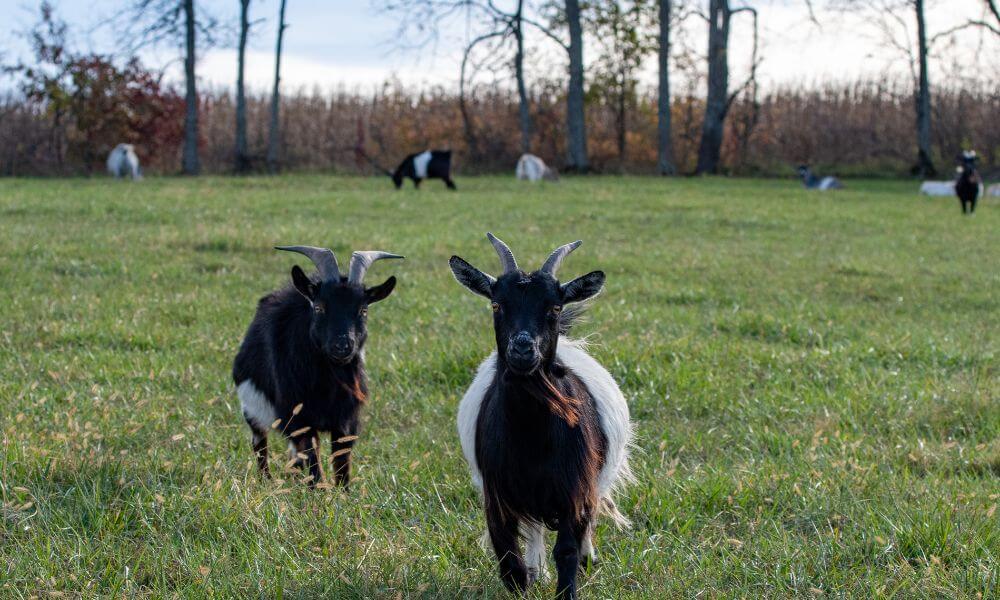There are many fun facts about pygmy goats and their ability to jump, plus helpful information about how to keep your goats safely enclosed given their jumping ability.
Read on to find out more!

What are pygmy goats?
Originally, pygmy goats came from western African countries and were called Cameroon Dwarf goats, because they came to the United States from the French Cameroon area.
These goats tend to be smaller in size, only standing fifteen to twenty inches high at the shoulders, on average.
While females weigh thirty-five to fifty pounds, males weigh forty to sixty pounds.
These goats come in a wide variety of shades of caramel, agouti, black and brown.
The pygmy goats’ coat consists of straight, medium-long hair that changes in density depending on the season and climate.
Female pygmies may or may not have beards, while adult males should grow full, long, flowy beards.
They will also have a mane that drapes majestically over their shoulders like a cape.
Pygmys are primarily considered meat goats, though they do produce small amounts of high-quality milk.
Unlike svelte dairy breeds, pygmy goats are bred to be more “cobby,” meaning compact and heavy boned.
In addition to being raised for meat, pygmy goats are frequently used as pets.
Why do goats jump?
Adult goats jump for a variety of reasons.
Sometimes they jump to find food, while other times they’re simply curious.
Ultimately, it’s a goat’s natural instinct to jump.
How do pygmy goats compare to other types of goats when it comes to jumping?
Mountain goats are the most active and agile goat species.
Although they can weigh the most at three hundred pounds, they also have the ability to jump the highest at twelve feet.
Boer goats, however, are the largest type of goat averaging two and half feet tall and weighing up to two hundred and thirty pounds.
Despite their prodigious size, their jumping ability is less impressive than the mountain goats’.
Boer goats can only jump three and a half feet.
Lastly, Nigerian Dwarf goats are similar to pygmy goats.
They are also a small and quiet species that can jump four feet high.
How high can a baby goat jump?
Baby goats can be about seventeen inches tall, and they have a lot of energy for jumping around.
It’s a natural instinct for goats to jump, especially babies.
It’s not uncommon to see a baby goat jumping straight into the air with all four feet.
This is called “stotting.” Baby goats jump for a variety of reasons, including play, releasing energy, and showing off.
While baby goats will jump a lot, they can’t jump as high as an adult, so they’re maximum height will only be a couple feet (certainly less than four feet).
Given how high a pygmy goat can jump, what kind of fence should you get?
It’s important to surround pygmy goats with a fence that will keep them safely enclosed in their designated area.
It is recommended to get a fence that is at least five feet high to prevent them from jumping over it.
Many goats will be able to hop over a four-foot fence.
What’s the best kind of fence for your goat?
When it comes to fencing, there are a variety of options.
One of the most common is woven wire fencing.
Despite its popularity, you’ll find woven wire fencing to be quite expensive and installing it is challenging.
If you choose to proceed with this method, it’s important that you keep to four-inch spaces so there’s no risk of the goat getting its head stuck inside the fence openings.
Another popular option is cattle or goat panels.
This variety of fencing is available in many different lengths and heights, which you can custom-tailor to your specific needs.
The taller and wider your fence is, the safer your goats will be.
The one downside to using a goat panel is that the tallest panels could be up to fifty-two inches, which is equivalent to four and a third of a foot.
A very active goat might still be able to jump over this height.
In this case, it’s recommended that you add several more linings of electric fence to the top in order to discourage goats from jumping over.
Electric fencing is also a great option for goats.
In addition to trying to jump over fences, goats will also try to go under them.
So, it’s important to put the lower wire of the electric fence as low to the ground as possible.
For goats, the voltage on the electric fence should be between four thousand and five thousand.
When building your fence, you should be aware that goats tend to rub against walls and fences, so it’s important to construct something durable.
For this reason, wooden and metal fence posts are advised because of their hardiness.
When inserting these poles, be sure to keep them eight to ten feet apart and buried at least two feet deep in the ground.
Lastly, be sure to put the corner posts on the outside of the fence, or else your goats will use them to climb up.
In addition to being enthusiastic jumpers, goats are also great climbers.
